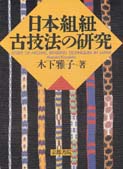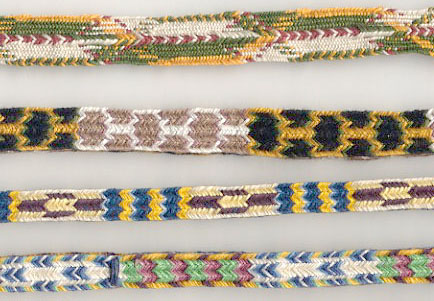|
|
|
Workshop general
|
|
Workshop program
|
|
Application
|
|
|
Materials fee
|
|
1000 yen each
|
|
 |
|
Auhor's book 1994
|
| |
 |
|
Masako Kinoshita
|
|
|
Students
|
Collyer Ekholm
Valerie Frey
Hiroko Fukuda
Michael Hattori
Anna Hurwitz
Nasako Imai
Sandy Jessett
Chieko Kako
Keishi Kikukawa
Lucinda Stephenson
Helen Vonow
Kathleen Warner
Eiko Yasuda
(13 of 15) |
|
| Masako Kinoshita |
|
Ithaca, USA
|
|
Making a Key Chain: L-m Braiding Introductory Course
This class introduces the methods for making the two most common f-h l-m
braids in regions outside Asia. Although these two braids are found among the majority
of people who live in these areas and use the f-h l-m braiding, they are rarely made
with other braiding methods and so are deemed as the hallmarks of the technique.
Participants make a key chain using a braid in a two-color design scheme incorporating
the two braids used in Peru and Bolivia. Each participant receives a set of the text
printouts. |
F-h l-m‘g•R‹Z–@‚М’†‚ЕЃAѓAѓWѓA‚рЏњ‚ў‚ДЃAђўЉE‚ЙЌЕ‚аЌL‚•Є•z‚·‚й‚ЖЊ©‚¦‚й‘g‚Э•ы‚Е‚·ЃBF-h
l-m‹Z–@€ИЉO‚Е‘g‚Ь‚к‚йЋ–‚Н–w‚З‚И‚ў‚М‚ЕЃA‚±‚М‹Z–@‚М–Ъ€у‚Ж‚і‚к‚йЏd—v‚И€У–Ў‚рЋќ‚В‘g•R‚Е‚·ЃB–Ш–ИЋhЏJЋ…‚р—p‚ў‚Д2Ћн—Ю‚МЌЕ‚аЉо–{“I‚И‘g‚Э•ы‚рЏK“ѕЊгЃAѓyѓ‹Ѓ[‚вѓ{ѓЉѓrѓA“™‚Е—p‚ў‚з‚к‚Д‚ў‚йЃA‚±‚М2Ћн‚ЙЉо‚Г‚•ї‚ѕ‚µ–@‚р‰ћ—p‚µ‚ДѓLЃ[ѓ`ѓFѓCѓ“‚рЌм‚и‚Ь‚·ЃB
Ќм‚и•ы‰рђа‚р”z•z‚µ‚Ь‚·ЃB |
|
Kute-uchi: Next Level Introductory Course
For those who have learned to make the three basic braids, this class introduces
loop braiding in which the loops are held around the hands (h-h), thus allowing one
to hold a larger number of the loops, and more importantly to manipulate loops in
four steps.
The participants, after making the three basic braids using the 2-step h-h method,
make Tsunegumi (an 8-ridge twill flat braid) and Mitake-gumi (a double square braid)
using 4-step procedures. They are two of the eight procedures that have been reconstructed
from "Soshun Biko (Notes on Braiding)," an Early Eighteenth Century Treatise.
Each participant receives a text-sample notebook on to which the sample swatches
made in the class may be affixed. |
ѓ‹Ѓ[ѓv‚рЋи‚ЙЉ|‚Ї‚Д‘ЂЌм‚·‚йЋи‘ЂЌм‹Z–@‚Ц‚М“ь–е‚Е‚·ЃBЋи‚Й‚©‚Ї‚ДЋќ‚ВЋ–‚Й‚ж‚Б‚ДЃAЋw‚ЙЉ|‚Ї‚й‚ж‚и‘Ѕђ”‚Мѓ‹Ѓ[ѓv‚ЄЋќ‚Д‚й‚Ж“ЇЋћ‚ЙЃA4’iЉK‘ЂЌм‚Є‰В”\‚Й‚И‚и‚Ь‚·ЃB
‚Ь‚ё–СЋ…‚р—p‚ў‚ДЋи‘ЂЌм2’iЉK‹Z–@‚Й‚ж‚й3Ћн—Ю‚МЌЕ‚аЉо–{“I‚И‘g•RЃF2ђ¤•Ѕ‘g•R‚р2–{“ЇЋћ‚Й‘g‚ЮЃA4ђ¤“›Џу‘g•RЃiЉp‘gЃjЃA4ђ¤•Ѕ‘g•R‚М‘g‚Э•ы‚р—ыЏK‚µ‚Ь‚·ЃBЋџ‚ў‚Е4’iЉKЋиЏ‡‚р—p‚ў‚й22—v‘f€Р‚µ–СЃi8ђ¤•Ѕ‘g•RЃj‚М‘g‚Э•ы‚Йђi‚Э‚Ь‚·ЃB
ѓNѓe‘Е‚НЌ]ЊЛЊгЉъ‚М•¶Џ‘Ѓu‘g‚µ‚г‚с”хЌlЃv‚©‚з•њЊі‚і‚к‚ЅЃA‹NЊ№‚НЊГ‘г‚Й‘k‚й‚ЖЌl‚¦‚з‚к‚й“ъ–{‚М‘g•R‹Z–@‚Е‚·ЃB
”z•z‚µ‚ЅѓeѓLѓXѓgЃEѓTѓ“ѓvѓ‹’ ‚ЙЌм‚Б‚ЅѓTѓ“ѓvѓ‹‚р“\•t‚µ‚Ь‚·ЃB |
|
|
|
Samples of the Medieval braids
|
 |
|